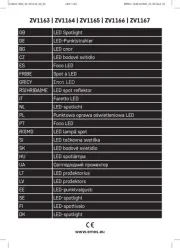Omiindustriies Ya Jerk Handleiding
Omiindustriies
Niet gecategoriseerd
Ya Jerk
Bekijk gratis de handleiding van Omiindustriies Ya Jerk (3 pagina’s), behorend tot de categorie Niet gecategoriseerd. Deze gids werd als nuttig beoordeeld door 38 mensen en kreeg gemiddeld 3.6 sterren uit 19.5 reviews. Heb je een vraag over Omiindustriies Ya Jerk of wil je andere gebruikers van dit product iets vragen? Stel een vraag
Pagina 1/3

Ya Jerk from omiindustriies is a two-channel chaotic signal
generator conceptualized as an argument between two
chaotic jerk functions. The two sides each represent a
different chaotic entity. It is broken up into two separate but
related chaotic signal generators that use JC Sprott’s Jerk
chaos circuit from the paper “A New Chaotic Jerk Circuit”
with some slight variations to optimize it for modular
synthesis. Sprott’s paper on Jerk chaos can be found .here
The two sides use slightly different implementations of the
jerk chaos, so you get two sets of related but different
chaotic signals. The two channels feature normalization
from one side to the other, creating a feedback loop that
provides influence over the resulting chaos.
The signals generated from Ya Jerk are not random so
much as chaotic, meaning that A: the previous state of the
chaotic system influences future states and B: small
changes to the system's state lead to large changes down
the road. Chaos tends to sit in that sweet spot of
unpredictable but bounded where your ear will pick up on
patterns as they emerge, but it won’t be so repetitive that
you can pick out an exact behavior before it happens as
the chaos moves through its states never quite the same
way twice.
Rude and Jeez control the shape of the outputs; turning
clockwise makes the outputs smoother and less jagged.
They control how the response of the module at each cycle
of the chaos, the kick of the jerk, so to speak. Different
settings correspond to the smoothness or jaggedness of
the resulting oscillations.

What The Heck? And Seriously? Control the system's relative speed and the amount of
decaying bounces. It’s closer to a slew generator than an oscillator frequency control, so turning
it clockwise increases the slewing and decreases the speed of the system. Due to the nature of
the chaos, the oscillations are often non-periodic, meaning they don’t oscillate the exact same
way twice. However, there are periods when the module simply oscillates in a periodic fashion.
Finding the sweet spot windows of periodicity and aperiodic behavior is part of the fun of the
module. The oscillations are fastest and roughest when the control is turned all the way
counterclockwise.
Influence introduces an external signal into the chaotic system. By default, the X output from the
Blue side and the Z output from the Red side are normalled into the opposing side, introducing
argumentative cross-modulation between the two chaotic systems. But this isn’t a modulation of
the frequency, more of an influence on the character of the chaos. Sending gates or triggers into
the input causes the module to loosely sync with them, but don’t expect perfectly in-tempo
modulation.
The influence controls are attenuverters, meaning in the center, the influence is off; turning
clockwise increases the influence positively, while counterclockwise increases the influence
negatively. The settings of the influence potentiometers heavily influence the behavior of the
chaos. Try setting both attenuverters positively and turning one in the negative direction to see
how that affects the outputs.
Each side of Ya Jerk has three outputs; X, Y, and Z. Due to the chaos being implemented
slightly differently between the Blue and Red sides, each output is distinct from the others. The
different pairs of outputs are similar to each other but have slight variations in their behavior.
The outputs are more complex than an LFO but less unpredictable than a smoothed random
voltage. The X outputs are the most jagged and jerky, typically behaving most like a bouncing
ball with a sharp onset and decaying sinusoidal bounces. The Y outputs are less violent and
smoother, and the Z outputs are the smoothest of the three. X and Y are the successive
derivatives of Z signal. The outputs swing up to approximately +/-10.5V, but the amplitude of the
outputs change with different settings. You may want to use Ya Jerk with an attenuator,
attenuverter, or VCA to reign in the amount of modulation.

The outputs from the Blue Channel and Influence Input
The outputs from the Red Channel and Influence Input
Product specificaties
| Merk: | Omiindustriies |
| Categorie: | Niet gecategoriseerd |
| Model: | Ya Jerk |
Heb je hulp nodig?
Als je hulp nodig hebt met Omiindustriies Ya Jerk stel dan hieronder een vraag en andere gebruikers zullen je antwoorden
Handleiding Niet gecategoriseerd Omiindustriies

21 Juni 2023

20 Juni 2023

16 Juni 2023
Handleiding Niet gecategoriseerd
- GoldenEar Technology
- Lenoxx
- Grundfos
- Boyo
- FXLab
- IClever
- Fulltone
- Vaude
- EPH Elektronik
- GOTIE
- Thrustmaster
- Premier Mounts
- Genius
- Nanlite
- Astropet
Nieuwste handleidingen voor Niet gecategoriseerd

19 Augustus 2025

19 Augustus 2025

19 Augustus 2025

19 Augustus 2025

19 Augustus 2025

19 Augustus 2025

19 Augustus 2025

19 Augustus 2025

19 Augustus 2025

19 Augustus 2025